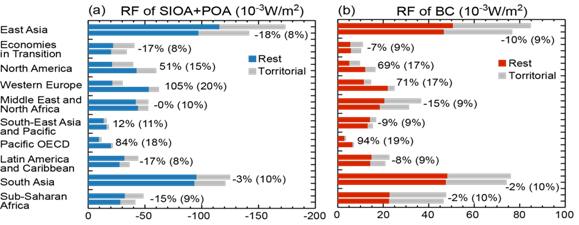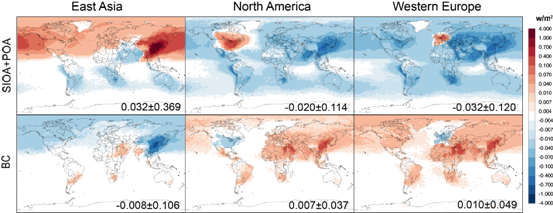Peking University, Sep. 9, 2016: On September 6th, an international collaborative study led by Peking University, Tsinghua University and McGill University was published in Nature Geoscience. The article revealed the complex impacts of international trade on aerosol pollution and its forcing on the global climate. Professor Lin Jintai in the Department of Atmospheric and Oceanic Sciences, School of Physics, Peking University, Professor Zhang Qiang at Tsinghua University and Professor Yi Huang at McGill University are the corresponding authors of the paper. Lin Jintai and Tong Dan, a graduate student from Tsinghua University, are the first authors.
Production of goods and related economic processes (transportation, power generation, etc.) result in tremendous amounts of air pollutant emissions. This impacts greatly on regional air quality and global atmospheric pollution transport. Aerosol (a.k.a. PM) pollution affects the climate system by scattering and absorption of solar radiation, the direct radiative forcing. It also interacts with the cloud-precipitation processes. In current globalized economy, international trade separates regions consuming goods and services from regions where goods and related aerosol pollution are produced. This has enormous consequences not only on regional pollution but also on radiative forcing of pollutants.
In their previous PNAS paper published in 2014, Lin et al. revealed for the first time the coupled mechanism for global pollution transfer through economic trade and atmospheric processes. Lin et al. showed that for 2006 alone, 23-34% of sulfate particulate concentrations, 10-23% of black carbon and 12-23% of carbon monoxide in the surface atmosphere of East China were caused by the country’s export-related emissions. Certain portions of China’s export-related pollutants were further transported by weather systems to the western United States and other downwind regions of China. This paper won the prestigious PNAS Cozzarelli Prize, and it has been downloaded by over 150,000 times. As of April 24th, 2015 the paper was ranked 65 out of 36323 PNAS papers recorded in Article Level Metrics.
In this Nature Geoscience study, Lin et al. further revealed the overall impacts of global multi-lateral economic trade and atmospheric processes on global air pollution, geographic transfer, and, for the first time, the top-of-atmosphere direct radiative forcing of aerosol pollution. The paper provides comprehensive data on radiative forcing (Fig. 1). For the forcing contributed by East Asia (mostly China), the largest net exporter region, aerosol radiative forcing that comes from its consumption (RFc) is much lower than from its production (RFp). The situation is the other way round for Western Europe, a giant net importer. Overall, international trade has transferred radiative forcing from developed countries to developing countries. Due to the short lifetime of aerosol pollutants, the difference between any region’s RFc and RFp has substantial geographical variability (Fig. 2), with important impactions for climate responses.
The studies of Lin et al. revealed strong yet previously hardly-recognized linkage between consumption, trade, and environmental and climate consequences, which calls for improved international cooperative efforts to reduce emissions in the exporting countries.
The Nature Geoscience research was funded by NSFC, 973 Project, and WWF.

Fig. 1: Global production- and consumption-based radiative forcing of SIOA+POA and BC for individual regions in 2007. (a and b) RFp (upper bar) and RFc (lower bar) contributed by individual regions, summed from the RF imposed above (grey) and outside (blue in a and red in b) their territories. For a given region, the percentage value indicates the relative change from RFp to RFc, and the value in the parenthesis is the associated error (2σ).

Fig. 2: Global differences between consumption- and production-based radiative forcing (RFc – RFp) in 2007.
References:
Lin, J.-T. *, Tong, D., Davis, S., Ni, R.-J. , Tan, X., Pan, D. , Zhao, H., Lu, Z., Streets, D., Feng, T., Zhang, Q. *, Yan, Y.-Y. , Hu, Y., Li, J., Liu, Z., Jiang, X., Geng, G., He, K., Huang, Y. *, and Guan, D.: Global climate forcing of aerosols embodied in international trade, Nature Geoscience, doi: 10.1038/NGEO2798, 2016 (link: http://dx.doi.org/10.1038/ngeo2798 )
Lin, J.-T. * , Pan, D. , Davis, S. J., Zhang, Q. *, He, K. *, Wang, C., Streets, D. G., Wuebbles, D. J., and Guan, D.: China’s international trade and air pollution in the United States, PNAS, 111, 1736-1741,doi:10.1073/pnas.1312860111, 2014 (link: http://www.pnas.org/content/111/5/1736?tab="metrics)

